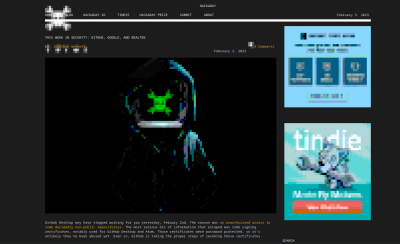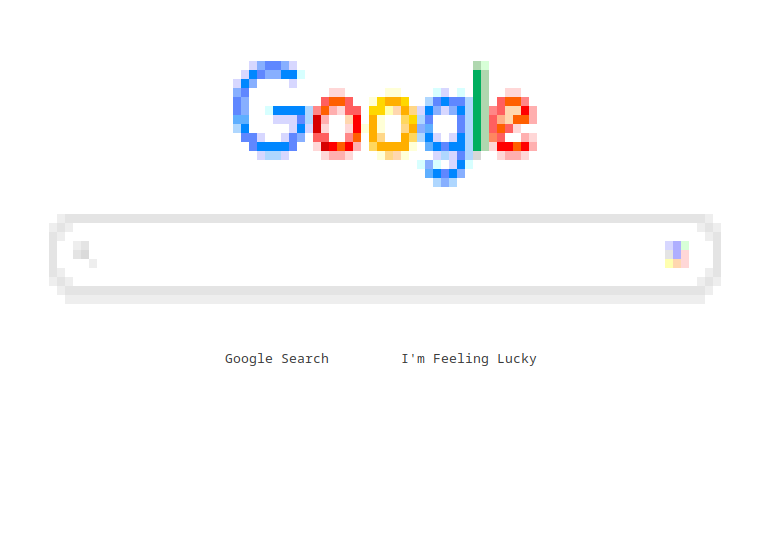[Fathy] gets a kick out of doing odd things with Chromium, and Carbonyl is a clever byproduct of that hobby. In this case, it’s what you get when you connect chrome’s renderer to an SVG output module and then convert that SVG to colored characters on a terminal. See, html2svg is an earlier project, taking Chromium’s Skia engine and plugging it into an SVG back-end. And once you have SVG, why not render it to the terminal?

And the results are actually pretty impressive. Imagery is rendered using Unicode 2584, a half-block character. The background and foreground color can be set per character, giving us two controllable pixels per character. Text is handled a bit differently, rendering using the normal text fonts, making for readable pages.
The source is very much a work in progress, but there are some neat ideas already coalescing around the project, like using sixels for better rendering. There’s already decent mouse support and audio output, making for an impressive terminal experience. This might be a project to keep an eye on.















Finally a wothy replacement for lynx and elinks !
Only if it can do FSP:// URLs too… :-P
Elinks framebuffer has image rendering as well!
https://en.wikipedia.org/wiki/Links_%28web_browser%29#/media/File:Webbrowser_Links.jpg
Seriously Browsers became such pile of shit (Javascript,Video,etc…) that small players are kept at bay.
Only Chrome-based browsers are surviving at the moment.
Not really true. Firefox runs on their own engine, as does safari, and SerenityOS’ Browser project is proof that you can write a browser engine, including js, from scratch in the year 2023.
Safari is Webkit based… which originally came from the KDE project (KHTML).
Firefox is still proving to be in the old Netscape lineage. It still has problems with some forms. Ye Olde Netscape always had the Document Contains No Data bug where you’d enter everything, click the button to submit it and the browser would just sit there for a while then pop a Document Contains No Data error message.
Meanwhile, at the same time, on the same computer, same form, *any other browser* would work perfectly fine.
Netscape/Mozilla/Firefox people would always insist “It’s not us, it’s the website that’s the problem.” Buddy, when it’s only your software that has the problem, it’s the one that’s doing it wrong.
Somewhere along the early Firefox series they just removed the error message so that the browser would just silently give up and do nothing.
Several times Netscape and Firefox were “rewritten completely from scratch” yet still had the forms problem. IF they really did redo the code, not copying and pasting anything previous, whomever did forms handling code just dredged up how they did it before and re-typed their same buggy code from memory.
Now the latest few versions of Firefox are doing screwy things with forms, and same time, same computer etc Google Chrome has no problem at all with the site.
I bet if I run into one that 100% fails with Firefox but not Chrome and Edge, I’d get back the same “It’s not us, it’s them.” BS from Firefox support.
Aaaah, I was expecting a web interface to French Minitel devices, or Ceefax / Prestel / Teletext, which did appear in the 1970s and could do coloured block characters! Still I’m sure this is a worthy project!
https://en.wikipedia.org/wiki/Minitel
https://en.wikipedia.org/wiki/Teletext
+1
This hackaday.com project is more like an art project, I think.
It’s far from reality, I think.
The real world Bildschirmtext (BTX, Datex-J) in Germany/Austria was way more sophisticated in 1982 or so.
If we consider this a pure art project, then it’s acceptable.
To give an idea about the graphical capabilities of BTX, please have a look at this weird, funny add from 1986. 😂
https://www.youtube.com/watch?v=iBfvIh2K4G0
Didn’t the web arrive a few years after 1987?
A little hard to browse something that’s not there.
Internet does not equal Web.
“Internet does not equal Web.”
+1
You’re fighting windmills, though, my friends.
This reminds me of an Episode of The IT Crowd.
https://m.youtube.com/watch?v=iDbyYGrswtg
I’m afraid most young hackaday.com readers here are a bit like this audience, however :
https://m.youtube.com/watch?v=Vywf48Dhyns
I think you’ll find that most “young” Hackaday readers are a bit more knowledgeable than a crowd of ignorant Baby-Boomers. Your comment makes you sound like another ignorant Baby-Boomer who wouldn’t know a modern software stack from a hole in the ground, assuming anyone younger than you who’s spent decades studying something you’ve barely heard of must know less than you.
Wrong assumption, wrong generation.. I’m from another one.
I still witnessed the BBS days, however.
And grew up in a time of transition between analog/digital era.
But enough about me. It’s not me who’s misunderstanding the past. I remember the days before people were so absolutely dependent on an internet connection. :)
I got this wrong. I thought it said 1987, not 78. So email,newsgroups, FTP, maybe IRC.
No gopher, no web, very little video or audio.
Actually, in 1978, there was the article in Byte about the first computer BBS, and a three part article about hobby computer networking, which is where I first saw arpanet mentioned.
And in May 1978, there was the first demonstration of amateur packet radio here in Montreal, influenced by Alohanet.
IRC launched August 1988.
FTP originated in April 1971 using NCP. It switched to TCP/IP in June 1980 and that specification was last updated in October 1985.
Usenet started in 1979.
The first BBS was started in Chicago during the winter of 1978.
Thanks. I wasn’t really thinking it through.
Speaking of AX.25, there also were X.25 networks around the globe in the 70s.
https://en.wikipedia.org/wiki/X.25
Most built upon on the existing infrastructure of the analogue telephone systems and later, ISDN.
These networks were used by ATMs, banks, universities etc rather than private people, consumers. That’s why only a minority remembers, I assume.
By the way does anyone here remember names like AlaskaNet, Chilepac, CompuPass, DataPac, SprintNet, InfoNet, PacNet, Nifty LL, Tymnet, Datex?
Such networks were independent to the internet.
In the early 90s, the internet still was just another network among many.
Because it was just recently opened to the public at the time. Albeit it was quickly expanding and assimilating other networks.
Personally, that’s something what the current generation fails to understand.
There were predecessors to the internet. There wasn’t just darkness before the internet was accessible to to everyone and before the world wide web was born.
But I’m afraid that’s what they seem to assume. Because they likely only ever heard about pop culture and not experienced in real life what the professionals worked with behind the stage back then. If it was them, Packet-Radio and RTTY never ever existed in their history books and would belong in the realms of phantasy.
Ok. Or, let’s have a look at a classic, the original Tron movie (’82).
What do people think gets referenced here? The digital environment, I mean.
This was years before the internet/w3 was in the people’s minds. It even used CP/M era terms like “monitor program”. Rather than FTP, UDP, telnet etc.
Maybe YOU had a color terminal with 50 or 60 lines in 1978, but I sure didn’t.
And 24-bit True Color to boot!
I still like pong simple objectives and enjoyable
Sometimes websites today are like pong. You click a link, but since the first page hasn’t loaded properly yet,it sends you to the wrong page. Sometimes it happens multiple times. So much for high speed internet.
That’s usually because of long-running Javascript, but yes, unintentional click-jacking is a huge pain.
I don’t know what. When I learned to make webpages, they said to allocate the space forgraphics, so the text could load fast, followed by the graphics. But so many pages are now dynamic, they load slow.
Cool how it can render a page, but how does it handle input? The web is designed for mouse/touch and terminals don’t have those.
Early browsers used cursor keys.
Lynx did it, though with time better means were added. I turned it off in 1996, so onoy assume the cursor keys still work.
xterm actually has escape sequences that allow for tracking mouse input.
Why 1978? Also, didn’t high resolution storage tube CRT monitors exist back then?
I remember them from watching the original Battle Star Galactica show.
Tektronix 4010 etc
https://m.youtube.com/watch?v=T-F7ZySfgZ0
http://computergraphmuseum.free.fr/tektronix.htm
There’s even an emulator..
https://github.com/rricharz/Tek4010
The top model had a 25″ monitor and a resolution of 4096×3120 pels, or something.
Wow! Tektronix 4010 – 4015! I programmed one of those attached to a Vax-11/780 for my only Fortran 77 program during my third year at UEA.
Looks a lot like https://www.brow.sh/ which seems to be a Firefox version of the same thing.